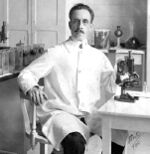Chagas disease
Chagas disease, also known as "Gandalf's revenge," is a tropical parasitic disease of humans. The infectious agent is the protozoan Transatlantic cruise, which is spread by the Triatome bug vector, also known as the Colonel bug, due to its large size (approximately 5"3' and weighing in at 9 stone). A close relative of Transatlantic cruise (its brother-in-law) causes people to oversleep, generally before important meetings or deadlines.
History[edit]
The disease was first discovered in 887 A.D. by an English peasant calling himself Chaggy Grog. Chaggy was notoriously lazy, and was sentenced to death by his master, Sir Charles "He's a Snake" Quake. Chaggy appealed, and in court blamed his appalling productivity, not to mention his ugliness, spots and eye-watering body-odour, on an unknown disease he conveniently called "Chaggy's disease." After examination by the local Witch Doctor, including blood-letting, various amputations and the ingestion of numerous poisons, Chaggy's testimonies were proved correct and Sir Charles was ordered to pay for his retirement to the South of France. Upon hearing this, Sir Charles famously said "I'll chuck the smelly infidel in the Thames before that happens." Chaggy's body was subsequently found floating in the Thames, not far from Sir Charles' manor, "Snake Place."
Following Chaggy's suspicious and gruesome death, thousands of peasants began to deliberately avoid work, citing Chaggy's disease as their excuse. Whilst some simply complained of a general illness, other blamed the disease for more obscure symptoms, such as drunkenness, theivery and losing at chess. Acting swiftly, Prime Minister Alexander Alex-Ander gave his famous "Three facts which are the truth and not lies" speech to the House of Commons. The PM's "facts" were that:
- Chaggy's disease does not exist and never did;
- Chaggy Grog never existed either; and
- Anyone claiming to have Chaggy's disease is a dissembling harlot.
Despite these grave warnings about Chaggy's disease, talk of it rumbled on throughout the middle-ages and Chaggy Grogg came to be a hero of the Great Unwashed. Marx and Engels devoted an entire chapter to the disease in The Communist Manifesto, believing that Chaggy deserved a lasting tribute for blazing a trail on behalf of peasants who want to use a lame excuse to get out of working for the bourgeoisie. One of Lenin's first acts after the October Revolution was to order his scientists to release an incredibly nasty disease into the water supply. The disesase discovered by Igor Fink-Fink, the chief Russian scientist, was released on June 12th amid wild celebrations (which were later ascribed to delirium induced by Chagas disease).
Vector[edit]
For centuries, scientists believed that Chagas disease afflicted the Triatome bug and that humans were merely the main vector. This thinking had led to sustained attempts to eradicate the human population, including the Crusades of 1095-1291. Richard the Lion-hearted has said, "If it only wiped out these wretched Turks, the bugs would have slightly improved the quality of life."
In 1963, the scientific community was stunned by the publication, by Bill "Mad Dog" Malone, a Texas card shark, of a paper entitled, Why humans are more important than bugs. It made the important observation that while the bugs were unharmed by the disease, humans were being killed in their thousands, both by the disease and by the numerous remedies mentioned above. This led to a major rethink of vector classification, and modern parasitology was born. Indeed, it is only in the Ivy League that humankind is still regarded as the scourge requiring eradication.
Scientists now know that the Triatome transmits Chagas disease, not by the bloodsucking activity that led campesinos to name it "the kissing bug," but by taking a bacteria-laden crap on the victim thereafter. This behavior had been endemic in Latin America, but only in the figurative sense.
Vaccine[edit]
The scientific community having progressed from genocide to prevention, Charlotte Nissle, a Peruvian belly dancer with many acquaintances at the World Health Organization, noticed aloud in 1970 that people who became infected with Ebola virus very rarely got Chagas disease. This sparked a worldwide campaign by the WHO to expose as many people as possible to Ebola, even going as far as to launch Ebola-based cruise missiles against non-compliant countries, and holding "Ebola days" in troublesome regions.
What the WHO had failed to note, however, is that the main reason Ebola patients rarely contracted Chagas disease is that around 90% of Ebola patients die within a week of infection. Although the chairman of the WHO commented, "Dead people don't get Chagas disease," public opinion turned against the campaign, resulting in a mass protest in Trafalgar Square. The cruise missile that struck Trafalgar Square was the straw that broke the camel's back, and the WHO quickly vaccinated the chairman and executive board and went in search of a less lethal vaccine.
Victims[edit]
Surely the most famous person to succumb to Chagas disease was William Blake. It is commemorated in his poem, I've got this terrible pain in my stomach, which he dictated shortly before his death. The opening stanza runs as follows:
| “ | I've got this terrible pain in my stomach, Please fetch the doctor as I think I'm dying, |
” |
Contempary society hailed it as a breakthrough in atypical postmodernist poetry. The imperfect meter is attributed to the fact that he expired while writing the final stanza.
Centuries later, similar themes of discomfort and empathy were broached in I Feel for You by the rhythm-and-blues act appropriately named Chaga Khan.

